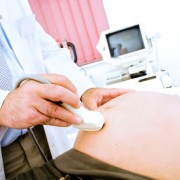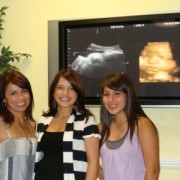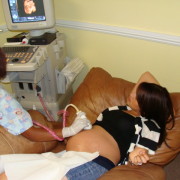Is ultrasound safe?
Yes, Ultrasound has been used safely in obstetrics for over 35 years. In the 35 years of use in medicine, there has never been a harmful effect shown by the use of ultrasound. Many women have multiple ultrasounds during their pregnancy with no negative effect on the baby. Women who are having trouble with pregnancy may have as many as two or three ultrasounds per week late in the third trimester.
Multiple Pregnancy Ultrasounds Safe for Child (www.WebMD.com)
Prenatal Peek® has a business practice of Licensing the Prenatal Peek® Trademark out to physicians, qualified sonographers or business entrepreneur that agree by contract to only have qualified sonographers perform ultrasound scans. In historical archives more data represents the safeness of ultrasound while being performed by a qualified professional.
The International Society for Ultrasound in Obstetrics and Gynecology (ISUOG), in 2002, stated: “Acoustic outputs are [generally] not high enough to produce deleterious effects. Their use therefore appears to be safe, for all stages of pregnancy.” (Abramowicz, et al. 105)
The American Pregnancy Association, “a national health organization committed to resolving reproduction, pregnancy and sexual health concerns through education, research, advocacy, and community awareness,” states the following: “[The] ultrasound is a non-invasive exam which poses no risks to the mother or developing fetus.” (Americanpregnancy.org)
Presently, ultrasound is as safe as ever, despite the false impression that 3-D/4-D technology poses greater risks than traditional 2-D. While conventional 2-D imaging requires a precise plane with which to observe the unborn baby, new techniques allow practitioners to freely rotate 3-D images of the scanned fetus within a stored volume. (Contemporary OB/GYN 4) Utilizing 3-D technology diminishes net exposure since volumetric images are rendered quickly and adjusted off-line.
Actually, 3-D/4-D “entertainment” scans that are performed by experienced, certified technicians often result in less exposure than those for diagnostic purposes. Volume acquisition, multiple 2-D images converted by computer into a detailed 3-D picture, occurs in seconds. Since the technician can manipulate images off-line (probe not in contact with skin) with no time limitations, “three-dimensional sonography reduces tremendously the time of exposure of [fetus] to the ultrasound beam.” (Kurjak 1)
“Entertainment” scans require higher intensity levels, and subject women and their unborn children to longer exposure time, especially when the technician is poorly trained or using improperly maintained equipment.
Kurjak, Asim. “3-D Ultrasound and Perinatal Medicine.” Journal of Perinatal Medicine 30 (2002): 5-8. Online.









